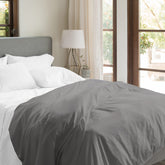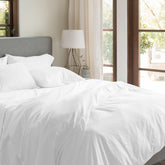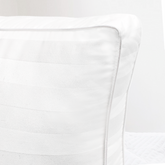When it comes to brightening your interior space, there are certain basic design principles that can help you to achieve that goal. These principles are simple to learn, and they’re useful for helping you to create that warm and comforting summertime atmosphere! Brightening your space also has the effect of brightening your mood and sense of well-being; this is really beneficial if you’re working from home or spending a lot of time at home. If your home feels too dark or drab, this can negatively impact your mood, sometimes causing feelings of pessimism or even fatigue. The good news? Brightening your space can turn all of that around!
Changing Up Your Color Palette
One of the simplest ways to brighten your space is by changing your color palette. This might mean repainting your walls or painting an accent wall, removing certain accessories, or adding new, brighter accents to space. To help you figure out ways to change around your color palette without requiring a major renovation, try these tips:
- Take time to assess your space. Ask yourself, “What is the primary color?” Usually, the primary color is the color of the walls or larger furniture items, such as your sofa, dining table, or bed.
- Ask yourself, “What are the secondary colors?” There will usually be at least one or two recurring accent tones – that you might not have noticed at first – present in your accessories, artwork, or other decorations.
- To brighten your space, ask yourself, “Does the primary color need to change? And if not, how could I change up the secondary colors?”
By asking yourself these questions, you can come up with a good approach for tweaking the color palette through changing either the primary or secondary colors. Changing the primary color is usually a bigger job since it will likely require repainting the walls and/or replacing certain furniture items. If that’s not in your budget, you can always just think about painting an accent wall and changing one or two of your secondary colors.

For example, if you want to paint an accent wall, consider a color that both complements and contrasts with your existing wall color. If your walls are blue, you could try a lovely, lighter blue on the accent wall. Or how about a soft white or cream? For your secondary colors, can you swap out one of your colors with a brighter tone, like yellow or orange; both contrast beautifully with blue walls. Also, consider varying the hue (how bright or how muted color is). So if you’re looking for a blue contrast, but bright orange or sunny yellow is a bit much, then look for more earthy or filtered tones such as paprika, curry orange, sandy-yellow tans, or natural jute or straw.
Brighten with White
Simply adding in some whites or creams will always brighten a space. But if you’ve been to a paint store, you’ve probably seen that there are hundreds of swatches. Having so many options can sometimes be a little overwhelming; so how do you choose your perfect white?

- Grab some of the white swatches from the paint store. Many times they’ll also have a brochure with a selection of featured whites. Grab that, too.
- Next, look to your space. Are most of your colors cool or warm?
- Find a piece of printer paper and lay out your swatches on it.
- Can you see how some of the whites look cooler or warmer? Can you detect any cool-color undertones (blue, green, or gray) or warm-color undertones (brown, pink, or yellow)?
- It’s okay if you can’t see these color shifts; not everyone can. Try picking the lightest of the whites that you like, and then test those in your room to see how they look to you and how they make you feel.
- For a calming feeling, choose a white with soft and similar undertones. For example, if your room has warm brown wood and leather tones, choose a white with soft tan undertones.
- For a more exciting or dramatic feeling, choose a white with contrasting undertones. If your room is blue, for example, then a warm white with soft yellow undertones or ivory can make the room look and feel fresher and more vibrant.
Choose Your Best Light
Having the right lighting can change boring into extraordinary. In the same vein, the wrong lighting can make your space look drab, or even feel somewhat chaotic. With the long, sunny days of summer, there’s plenty of natural light available. Make sure to open those curtains to let in some sunlight, and even open up the windows to let in some fresh air (if it’s not too hot)! Change up your drapes if you can, too. Replacing heavy, dark curtains with something more light and airy can make a big difference!

Besides letting in natural sunlight to brighten your space, it’s also important to pay attention to the quality of light you’re getting from your light fixtures. You want to make sure you have the right illumination when it’s dark outside, too.
- Walk through your home. Take a notepad and count how many missing or burned-out bulbs you have. Then take another walk through with a fresh set of eyes. How many mismatched lightbulbs do you have?
- Start to pay attention to the color of the light coming from the overhead cans, lamps, and sconces. Do you see a rainbow of multiple colors coming out of your lamps and fixtures? You could easily have a combination of white, off-white, yellow, and maybe even pink all in the same room. Do the same on the outside of your home.
- When you go shopping for lightbulbs, there’s really a multitude of choices these days – some stores even have an entire aisle dedicated to this. Many people just shop by price, or will only look for a brand they recognize. What’s more important is that you consistently choose the same color of light for every fixture in a single room or space, depending on your preferences.
- Having the ability to control the light intensity with a dimmer switch is a nice feature which allows you to completely change how a room feels. Ever noticed the soft, warm glow of the lighting at some restaurants? It helps to create a more relaxing, comfortable environment, and it even makes your food look better, too. The bright, fluorescent light of a cafeteria can’t create this same effect.
- A single overhead light in the middle of a ceiling can make a room feel dark, especially in kitchens, home offices, and other spaces. The reason for this is that no matter where you are in the room, regardless of how bright the bulb is, you’re always looking into your own shadow. If you do nothing more than simply double the lighting to two overhead fixtures, this alone will make your room look and feel much brighter.

Once you try these simple design tips, you’ll quickly notice the difference a few changes can make to brighten your space—and to brighten your mood. Enjoy, and be well!






